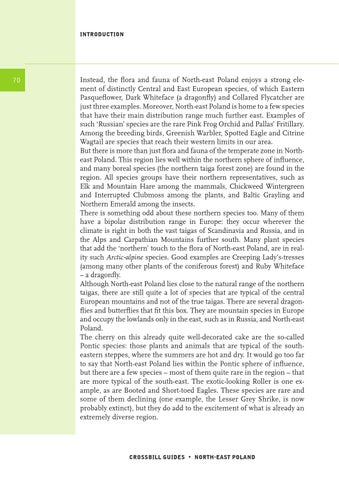introduction
70
Instead, the flora and fauna of North-east Poland enjoys a strong element of distinctly Central and East European species, of which Eastern Pasqueflower, Dark Whiteface (a dragonfly) and Collared Flycatcher are just three examples. Moreover, North-east Poland is home to a few species that have their main distribution range much further east. Examples of such ‘Russian’ species are the rare Pink Frog Orchid and Pallas’ Fritillary. Among the breeding birds, Greenish Warbler, Spotted Eagle and Citrine Wagtail are species that reach their western limits in our area. But there is more than just flora and fauna of the temperate zone in Northeast Poland. This region lies well within the northern sphere of influence, and many boreal species (the northern taiga forest zone) are found in the region. All species groups have their northern representatives, such as Elk and Mountain Hare among the mammals, Chickweed Wintergreen and Interrupted Clubmoss among the plants, and Baltic Grayling and Northern Emerald among the insects. There is something odd about these northern species too. Many of them have a bipolar distribution range in Europe: they occur wherever the climate is right in both the vast taigas of Scandinavia and Russia, and in the Alps and Carpathian Mountains further south. Many plant species that add the ‘northern’ touch to the flora of North-east Poland, are in reality such Arctic-alpine species. Good examples are Creeping Lady’s-tresses (among many other plants of the coniferous forest) and Ruby Whiteface – a dragonfly. Although North-east Poland lies close to the natural range of the northern taigas, there are still quite a lot of species that are typical of the central European mountains and not of the true taigas. There are several dragonflies and butterflies that fit this box. They are mountain species in Europe and occupy the lowlands only in the east, such as in Russia, and North-east Poland. The cherry on this already quite well-decorated cake are the so-called Pontic species: those plants and animals that are typical of the southeastern steppes, where the summers are hot and dry. It would go too far to say that North-east Poland lies within the Pontic sphere of influence, but there are a few species – most of them quite rare in the region – that are more typical of the south-east. The exotic-looking Roller is one example, as are Booted and Short-toed Eagles. These species are rare and some of them declining (one example, the Lesser Grey Shrike, is now probably extinct), but they do add to the excitement of what is already an extremely diverse region.
crossbill guides • North-east Poland
